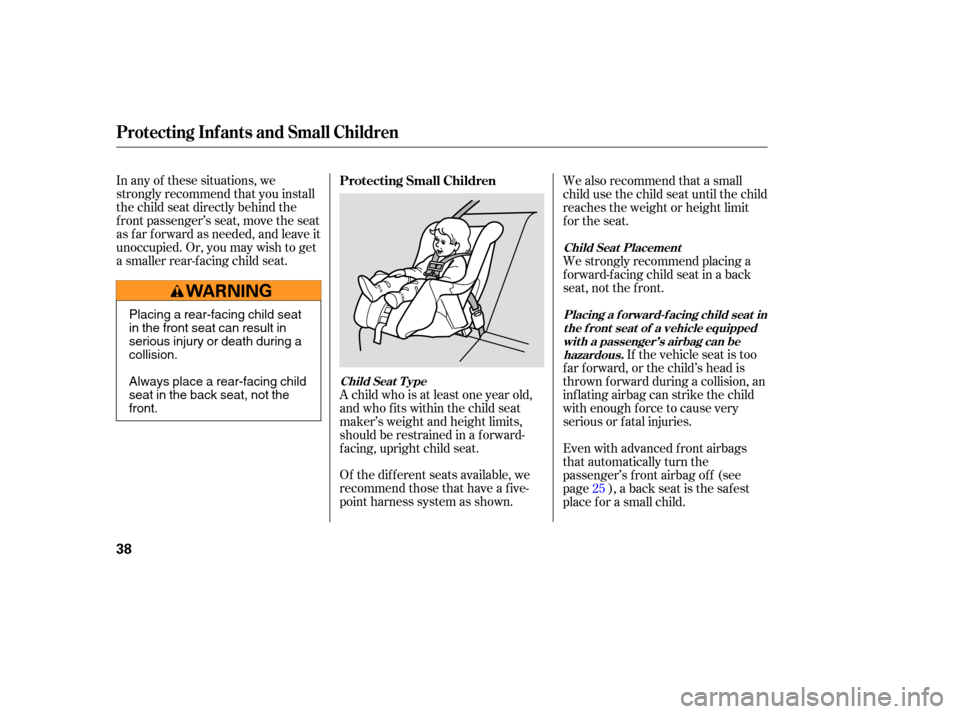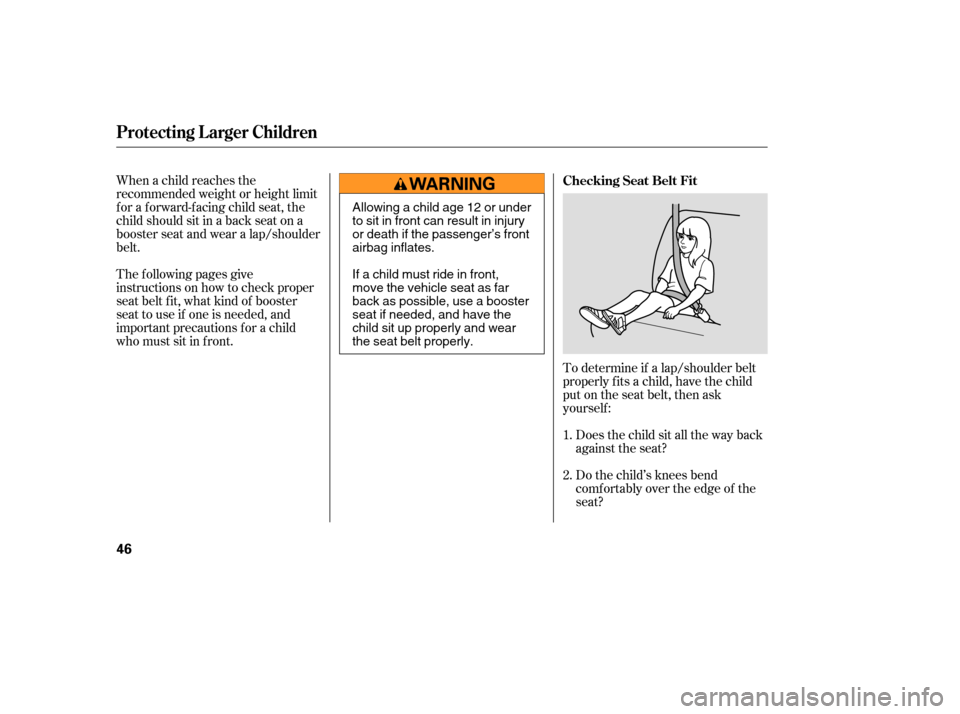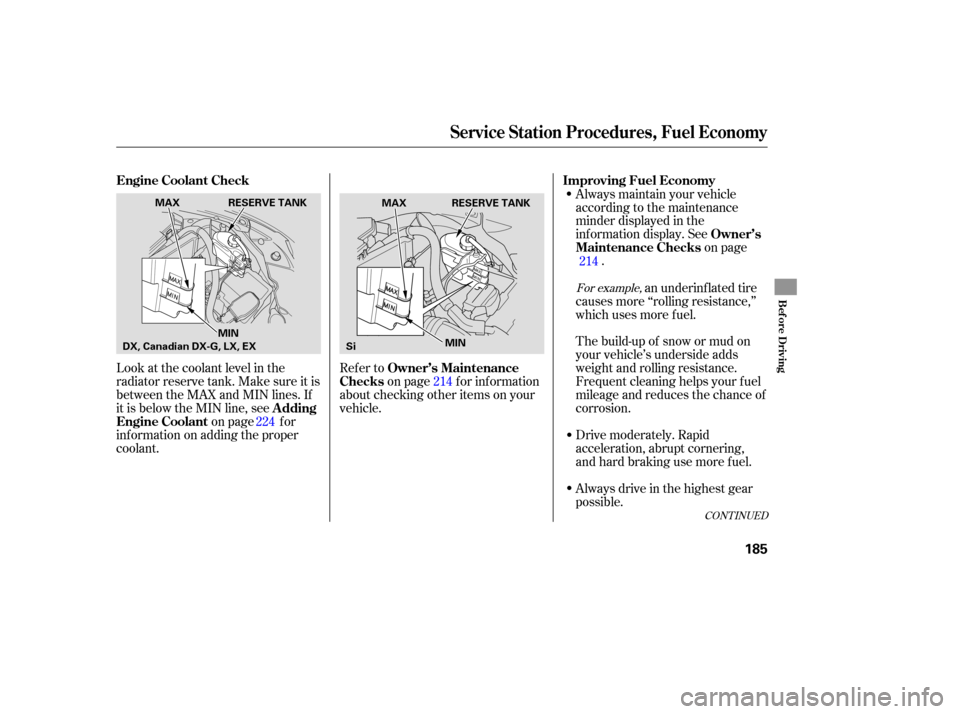Page 42 of 307

Of the different seats available, we
recommend those that have a f ive-
point harness system as shown.
In any of these situations, we
strongly recommend that you install
the child seat directly behind the
f ront passenger’s seat, move the seat
as far forward as needed, and leave it
unoccupied. Or, you may wish to get
a smaller rear-f acing child seat.
A child who is at least one year old,
and who fits within the child seat
maker’s weight and height limits,
should be restrained in a f orward-
facing, upright child seat. Even with advanced front airbags
that automatically turn the
passenger’s front airbag off (see
page ), a back seat is the saf est
place f or a small child. If the vehicle seat is too
f ar f orward, or the child’s head is
thrown f orward during a collision, an
inf lating airbag can strike the child
with enough force to cause very
serious or fatal injuries. We strongly recommend placing a
forward-facing child seat in a back
seat, not the f ront. We also recommend that a small
child use the child seat until the child
reaches the weight or height limit
for the seat.
25
Protecting Small Children
Child Seat T ype
Placing a f orward-f acing child seat in
the f ront seat of a vehicle equippedwith a passenger’s airbag can behazardous.
Child Seat Placement
Protecting Inf ants and Small Children
38
Placing a rear-facing child seat
in the front seat can result in
serious injury or death during a
collision.
Always place a rear-facing child
seat in the back seat, not the
front.
�����—�����—�����y�
�������������y���
�(�+���������y�������
�y
Page 48 of 307
Af ter conf irming that the belt is
locked, grab the shoulder part of
the belt near the buckle, and pull
up to remove any slack from the
lap part of the belt. Remember, if
the lap part of the belt is not tight,
the child seat will not be secure.Push and pull the child seat
f orward and f rom side-to-side to
verify that it is secure enough to
stay upright during normal driving
maneuvers. If the child seat is not
secure, unlatch the belt, allow it to
retract f ully, then repeat these
steps.
To remove slack, it may help to
putweightonthechildseat,or
push on the back of the seat while
pulling up on the belt. To deactivate the locking
mechanism and remove a child seat,
unlatch the buckle, unroute the seat
belt, and let the belt f ully retract.
4. 5.
Installing a Child Seat
44
�����—�����—�����y�
�������������y���
�(�+���������y���������y
Page 50 of 307

When a child reaches the
recommended weight or height limit
for a forward-facing child seat, the
child should sit in a back seat on a
booster seat and wear a lap/shoulder
belt.
The f ollowing pages give
instructions on how to check proper
seat belt f it, what kind of booster
seat to use if one is needed, and
important precautions f or a child
who must sit in f ront.To determine if a lap/shoulder belt
properly f its a child, have the child
put on the seat belt, then ask
yourself :Does the child sit all the way back
against the seat?
Do the child’s knees bend
comf ortably over the edge of the
seat?
1.
2. Checking Seat Belt Fit
Protecting L arger Children
46
Allowing a child age 12 or under
to sit in front can result in injury
or death if the passenger’s front
airbag inflates.
If a child must ride in front,
move the vehicle seat as far
back as possible, use a booster
seat if needed, and have the
child sit up properly and wear
the seat belt properly.
�����—�����—�����y�
�������������y���
�(�+���������y���������y
Page 51 of 307

Does the shoulder belt cross
between the child’s neck and arm?
Is the lap part of the belt as low as
possible, touching the child’s
thighs?
Will the child be able to stay
seated like this f or the whole trip?
If you answer yes to all these
questions, the child is ready to wear
the lap/shoulder belt correctly. If
you answer no to any question, the
child needs to ride on a booster seat. A child who has outgrown a f orward- f acing child seat should ride in a
back seat and use a booster seat
until the lap/shoulder belt f its them
properly without the booster.Some states and Canadian provinces
also require children to use a booster
seat until they reach a given age or
weight (e.g., 6 years or 60 lbs). Be
sure to check current laws in the
states or provinces where you intend
to drive.
Booster seats can be high-back or
low-back. Whichever style you select,
make sure the booster seat meets
f ederal saf ety standards (see page
) and that you f ollow the booster
seat maker’s instructions.
If a child who uses a booster seat
must ride in f ront, move the vehicle
seat as far back as possible, and be
sure the child is wearing the seat
belt properly.
3.
4.
5.
39
CONT INUED
Using a Booster Seat
Protecting L arger Children
Driver and Passenger Saf ety
47
�����—�����—�����y�
�������������y���
�(�+���������y���������y
Page 62 of 307

This indicator has two f unctions:Itcomesonwhenyouturnthe
ignition switch to the ON (II)
position. It is a reminder to check
the parking brake. A beeper
sounds if you try to drive with the
parking brake not f ully released.
Driving with the parking brake not
fully released can damage the
brakes and tires.
If it stays on after you have fully
released the parking brake while
the engine is running, or if it
comes on while driving, there
could be a problem with the brake
system. For more inf ormation, see
page . This indicator comes on brief ly when
you turn the ignition switch to the
ON (II) position. If it comes on at
any other time, it indicates a
potential problem with your f ront
airbags. This indicator will also alert
you to a potential problem with your
side airbags, passenger’s side airbag
automatic cutoff system, side curtain
airbags, automatic seat belt
tensioners, driver’s seat position
sensor, or the f ront passenger’s
weight sensors. For more
inf ormation, see page .
This indicator comes on when you
turn the ignition switch to the ON
(II) position. If it comes on at any
other time, it indicates that the
passenger’s side airbag has
automatically shut off. For more
inf ormation, see page .
1.
2.
265 28
29
Parking Brake and Brake System
Indicator
Supplemental Restraint
System Indicator
Side Airbag Of f Indicator
Instrument Panel Indicators
58
U.S. Canada U.S. Canada
�����—�����—�����y�
�������������y���
�(�+���������y�������
�y
Page 99 of 307

Make sure all rear shoulder belts are
positioned in f ront of the rear seat-
back whenever it is in the upright
position.
Do not put any heavy items on the
seat-back when it is folded.
Make sure all items in the trunk, or
items extending through the opening
into the back seat, are secured.
Looseitemscanflyforwardand
cause injury if you have to brake
hard. See on page.
Never drive with the seat-back
f olded down and the trunk lid open.
See on
page .
Make sure that the f olded-down rear
seat does not interf ere with the f ront
passenger’s seat-back. This will
cause the f ront passenger’s weight
sensors to work improperly (see
page ). This may also cause the
seat belt reminder indicator f or a
f ront passenger to work improperly.
Also, check the passenger airbag of f
indicator to assure the proper
operation of the passenger’s
advanced front airbag.
To lock the seat-back upright, push it
f irmly against the trunk panel. Make
sure it is latched in place by pulling
on the top of the seat.
25
18850Carrying Cargo
Carbon Monoxide Hazard
Seats
Inst rument s and Cont rols
95
�����—�����—�����y�
�������������y���
�(�+���������y���������y
Page 189 of 307

CONT INUED
Look at the coolant level in the
radiator reserve tank. Make sure it is
between the MAX and MIN lines. If
it is below the MIN line, seeon page f or
inf ormation on adding the proper
coolant. Refer to
on page f or inf ormation
about checking other items on your
vehicle. Always maintain your vehicle
according to the maintenance
minder displayed in the
inf ormation display. See
on page
.
Always drive in the highest gear
possible. Drive moderately. Rapid
acceleration, abrupt cornering,
and hard braking use more f uel. The build-up of snow or mud on
your vehicle’s underside adds
weight and rolling resistance.
Frequent cleaning helps your f uel
mileage and reduces the chance of
corrosion. an underinf lated tire
causes more ‘‘rolling resistance,’’
which uses more f uel.
214
224 214
For example,
A dding
Engine Coolant Owner’s Maintenance
Checks
Engine Coolant Check
Improving Fuel Economy
Owner’s
Maintenance Checks
Service Station Procedures, Fuel Economy
Bef ore Driving
185
RESERVE TANK
SiRESERVE TANK
MAX
MIN
MAX
MIN
DX, Canadian DX-G, LX, EX
�����—�����—�����y�
������
������y���
�(�+���������y���
�����y
Page 193 of 307

�µ�·
Determine the combined weight
of luggage and cargo being loaded
in the vehicle. That weight may
not saf ely exceed the available
cargo and luggage load capacity in
step 4.
Steps f or determining correct load
limit:
Locate the statement, ‘‘the
combined weight of occupants and
cargo should never exceed 850
lbs’’ on your vehicle’s placard.
[The placard is on the driver’s
doorjamb.]
Determine the combined weight
of the driver and passengers that
will be riding in your vehicle.
In addition, the total weight of the
vehicle, all passengers, accessories,
and cargo must not exceed the Gross
Vehicle Weight Rating (GVWR) or
the Gross Axle Weight Rating
(GAWR). Both are on a label on the
driver’s doorjamb.The resulting f igure equals the
available amount of cargo and
luggage load capacity.
For example, if the maximum load
is 850 lbs and there will be f ive 150
lb passengers in your vehicle, the
amount of available cargo and
luggage load capacity is 100 lbs.
(850 750 (5 150) = 100 lbs.)
The maximum load f or your vehicle
is 850 lbs (385 kg) f or U.S. models
and 395 kg for Canadian models.
This f igure includes the total weight
of all occupants, cargo, and
accessories.
Subtract the combined weight of
the driver and passengers f rom
850 pounds.
1.
2.
3. 4.
5.
Carrying Cargo
Load Limits
Bef ore Driving
189
Overloading or improper
loading can affect handling and
stability and cause a crash in
which you can be hurt or killed.
Follow all load limits and other
loading guidelines in this
manual.
�����—�����—�����y�
�������������y���
�(�+���������y���
�����y